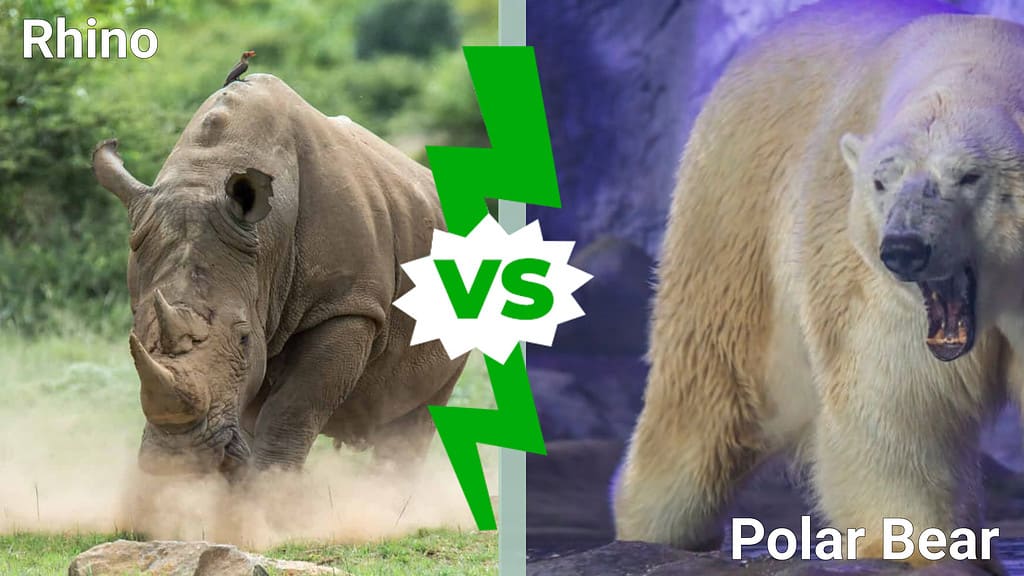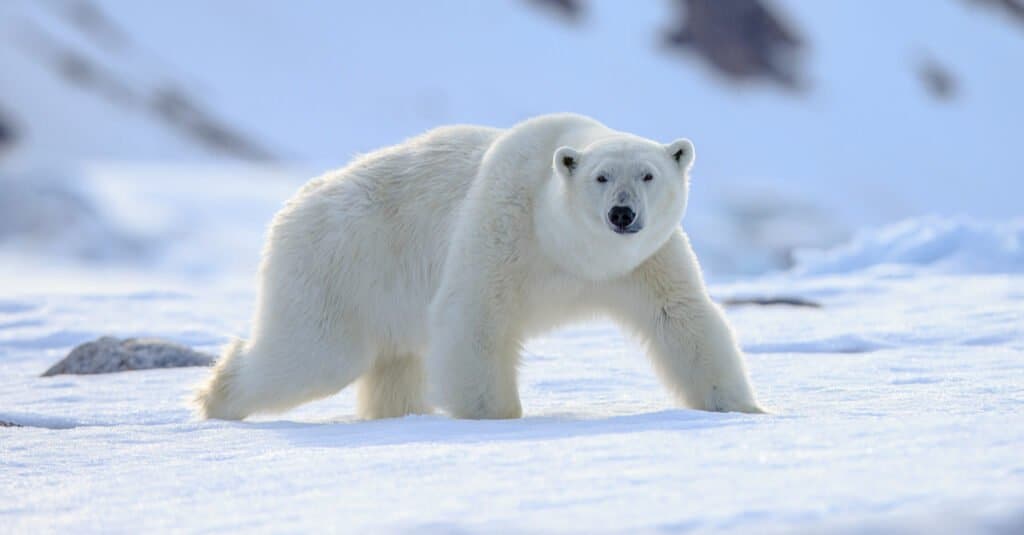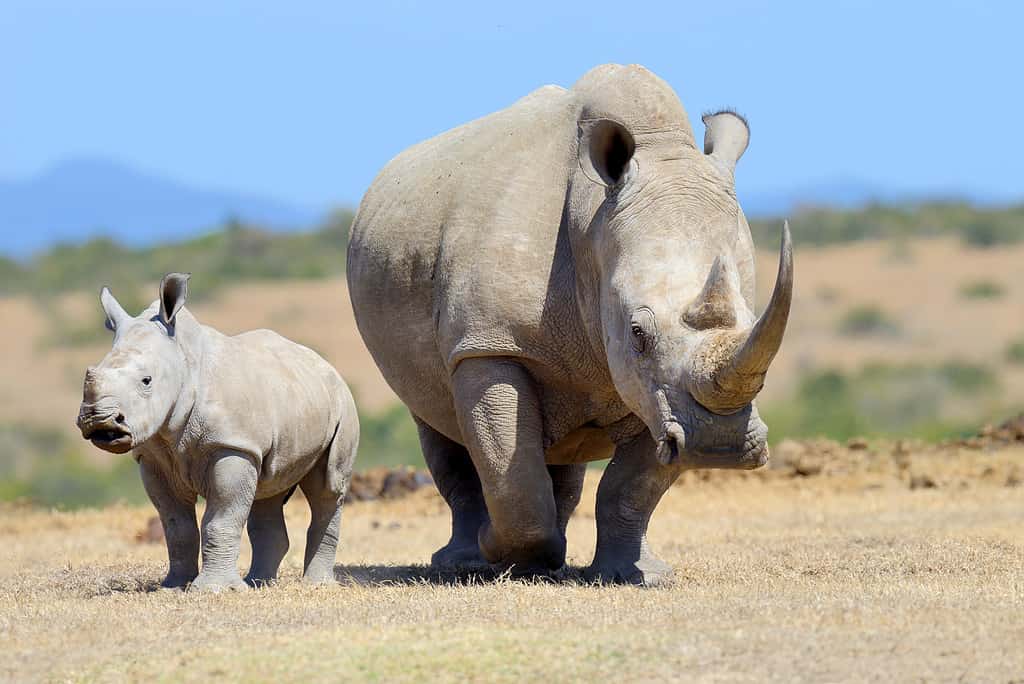The world has a few heavyweight animals that would make for interesting opponents but remain separated by their natural range. Rhinos are massive ungulates that roam parts of Africa and Asia. Meanwhile, polar bears are some of the largest extant bears in the world, and they live in the northernmost reaches of the planet. Although these two animals would never meet in the wild, we’re going to imagine they did somehow. Find out which animal wins a rhino vs. polar bear fight and learn about the factors that determine the survivor.
Comparing a Rhino and a Polar Bear

| Rhino | Polar Bear | |
|---|---|---|
| Size | Weight: 1,700 to 5,000 pounds, up to 7,700 pounds Height: 4.3 to 6 feet tall at the shoulder Length: between 11 and 15 feet | Weight: 330 to 1,300 pounds Height: 3.5 to 5 feet at the shoulder Length: 6 to 9.5 feet |
| Speed | – 20 to 35 mph | – 25 mph – 6 mph when swimming |
| Defenses | – Large bodies – Skin that can reach 2 inches thick – Good speed to evade danger | – Polar bears are very large, intimidating creatures – They have a thick layer of fur and skin – Polar bears can swim in frigid waters – Great sense of smell that helps it locate prey – Yellowish-white fur helps polar bears blend in with their surroundings |
| Offensive Capabilities | – Rhinos have large horns between 8 and 30 inches long or longer – Rhinos can use horns to gore attackers – These mammals can charge and trample their prey – Bite force of 1,000 PSI | – Polar bears have a very powerful 1,200 PSI bite – Teeth grow up to 2 inches long – Powerful forelegs with massive paws and 4-inch claws |
| Predatory Behavior | – Herbivore that does not hunt | – Can ambush seals by waiting for them to surface on ice – Also scavenge other foods, including carcasses – May also pursue prey on land or in the water, including reindeer |
What Are 2 Key Differences Between a Rhino and a Polar Bear?

Polar bears hunt on land and in the water.
©Vaclav Sebek/Shutterstock.com
Before we look at the fight between these two animals, we have to understand their differences. Looking at them, two primary differences emerge: the animals’ size and the way they obtain food. Rhinos are much larger than polar bears. Rhinos can weigh anywhere from 1,700 pounds to 5,000 pounds depending on their sex and species. However, they can weigh over 7,000 pounds in some cases. Also, they stand between 4.3 and 6 feet tall at the shoulder and grow about 11 to 15 feet long.
Meanwhile, polar bears weigh between 330 and 1,300 pounds. The largest polar bear ever recorded weighed 2,209 pounds and stood 11 feet 1 inch tall on its hind legs. Any way we look at it, rhinos are bigger.
However, polar bears are opportunistic omnivores, often hunting marine prey like seals. They also feed on walruses, carrion, fish, certain plants, and human foods. Rhinos lack a prey drive, only eating plants.
These two differences will define the fight, but we must consider other factors before declaring a winner.
What Are the Key Factors in a Fight Between a Rhino and a Polar Bear?

Polar bears are smaller than rhinos, but they are still vicious fighters.
©kristian brasel/Shutterstock.com
The key factors in most fights in the wild are size, offensive capabilities, defenses, speed, and predation method. This fight is no different. So, we’re going to examine all of those facets of the fight, naming the animal that has the advantage in each case.
Rhino vs. Polar Bear: Size
The average rhino is much larger than a polar bear. Rhinos vary in size based on their species and other factors. However, they weigh between 1,700 pounds and 5,000 pounds, but they can reach up to 7,700 pounds at their greatest weight. The animals are about 11 to 15 feet long, and they can reach 6 feet tall at the shoulder. They’re massive mammals.
Polar bears are very large in their own right. They can grow between 330 and 1,300 pounds. They may reach lengths of 6 to 9.5 feet, and they can stand between 3.5 and 5 feet tall at the shoulder. Larger members of the species have been recorded, though.
Rhinos have the size advantage in this fight.
Rhino vs. Polar Bear: Speed
Polar bears are very large, bulky animals. Still, they can hustle when they need to get somewhere fast. The average polar bear can reach speeds of 25 miles per hour on land. Rhinos, despite being much larger and heavier than polar bears, can actually run faster. These creatures can move at speeds of 20 to 35 miles per hour when they’re moving at top speeds.
Rhinos have the speed advantage in this fight.
Rhino vs. Polar Bear: Defenses
Polar bears are very large, intimidating animals, and they’re the deadliest creatures in their habitats. Their defenses are powerful even though they don’t have much to worry about in terms of predators. Polar bears have an imposing figure, thick fur and skin, fur that blends into their environment, and a great sense of smell to help them find prey.
Rhinos have large bodies, skin that can be up to 2 inches thick, and the ability to run at speeds of 35 miles per hour to get away from trouble. Although both animals are similar in their defenses, rhinos are much larger and more thickly built than polar bears.
Rhinos have the defensive advantage in this fight.
Rhino vs. Polar Bear: Offensive Capabilities
Polar bears are absolutely frightening creatures that hunt and kill sizeable animals like ringed seals without much of a fight. Polar bears have 2-inch-long teeth, and they have a bite force of about 1,200 PSI. That is the strongest bite of any bear species. Also, polar bears have very large paws with 4-inch-long claws. They can instantly kill animals with a single smash from their paws.
Rhinos are not predators. However, they can fight rather well. Some rhinos have horns that measure between 8 and 30 inches long. Rhinos can easily gore attackers, puncturing organs and causing major blood loss. These creatures also like to use their size and speed to take down attackers. They charge and knock over other animals before goring and stomping them. Rhinos also have a bite force of nearly 1,000 PSI. They have many different ways to harm other animals.
Polar bears and rhinos both have very powerful but different attacks, so we’re calling this statistic a tie.
Rhino vs. Polar Bear: Predatory Behavior
Polar bears are ambush predators in many cases. They’ll often wait above the holes in arctic ice for seals to emerge. Once the seals come up, the polar bear will savagely smash them with their paws, drag them onto the ice, and then start eating them.
Rhinos are not predators, so they have no predator behaviors.
Polar bears have the advantage in predator behaviors.
Who Would Win in a Fight Between a Rhino and a Polar Bear?

Rhinos have a great mix of offense and defense that would overwhelm a polar bear.
©Volodymyr Burdiak/Shutterstock.com
A rhino would win a fight against a polar bear. Rhinos are much too large for a polar bear to successfully attack. These tank-like animals have very thick skin, so thick that polar bears would have a hard time trying to land a killing blow. Between a rhino’s thick skin and large body, polar bears would not have a way to win the fight.
Meanwhile, the much larger, heavier of the two animals would have several ways of killing a polar bear. A rhino could bowl over a polar bear, gore it, and stomp on it, causing significant damage to the bear, even killing it. Either way, the fight would be ferocious, but the rhino would come out on top. Again, this fight would never happen in the wild, but if it did, the rhino would win.
The photo featured at the top of this post is © Roger de la Harpe/Shutterstock.com
Thank you for reading! Have some feedback for us? Contact the AZ Animals editorial team.







